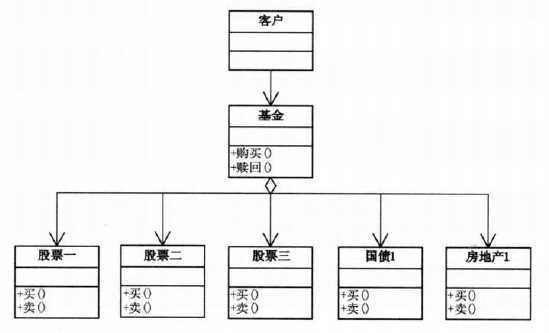标签:style blog http color 使用 strong
外观模式(Facade),为子系统中的一组接口提供一个一致的界面,此模式定义了一个高层接口,这个接口使得这一子系统更加容易使用。
外观模式结构图:
代码模板:
//四个子系统的类
class SubSystemOne
{
public:
void MethodOne()
{
cout << "子系统方法一" << endl;
}
};
class SubSystemTwo
{
public:
void MethodTwo()
{
cout << "子系统方法二" << endl;
}
};
class SubSystemThree
{
public:
void MethodThree()
{
cout << "子系统方法三" << endl;
}
};
class SubSystemFour
{
public:
void MethodFour()
{
cout << "子系统方法四" << endl;
}
};
//外观类,它需要了解所有的子系统的方法或属性
class Facade
{
private:
SubSystemOne *one;
SubSystemTwo *two;
SubSystemThree *three;
SubSystemFour *four;
public:
Facade()
{
one = new SubSystemOne();
two = new SubSystemTwo();
three = new SubSystemThree();
four = new SubSystemFour();
}
void MethodA()
{
cout << "方法组A()---" << endl;
one->MethodOne();
two->MethodTwo();
four->MethodFour();
}
void MethodB()
{
cout << "方法组B()---" << endl;
two->MethodTwo();
three->MethodThree();
}
};
//客户端调用,由于Facede的作用,客户端可以根本不知道子系统类的存在
int main()
{
Facade *facade=new Facade();
facade->MethodA();
facade->MethodB();
return 0;
}
下面举个买卖股票的例子:
代码结构图:

class Stock1 { public: void Sell() { cout << "股票1卖出" << endl; } void Buy() { cout << "股票1买入" << endl; } }; class Stock2 { public: void Sell() { cout << "股票2卖出" << endl; } void Buy() { cout << "股票2买入" << endl; } }; class Stock3 { public: void Sell() { cout << "股票3卖出" << endl; } void Buy() { cout << "股票3买入" << endl; } }; class NationalDebt1 { public: void Sell() { cout << "国债1卖出" << endl; } void Buy() { cout << "国债1买入" << endl; } }; class Realty1 { public: void Sell() { cout << "房地产1卖出" << endl; } void Buy() { cout << "房地产1买入" << endl; } }; //外观 class Fund { private: Stock1 *gu1; Stock2 *gu2; Stock3 *gu3; NationalDebt1 *nd1; Realty1 *rt1; public: Fund() { gu1=new Stock1(); gu2=new Stock2(); gu3=new Stock3(); nd1=new NationalDebt1(); rt1=new Realty1(); } void BuyFund() { gu1->Buy(); gu2->Buy(); gu3->Buy(); nd1->Buy(); rt1->Buy(); } void SellFund() { gu1->Sell(); gu2->Sell(); gu3->Sell(); nd1->Sell(); rt1->Sell(); } }; int main() { Fund *jijin=new Fund(); jijin->BuyFund(); jijin->SellFund(); return 0; }
外观模式使用的时机,我们要从三个阶段来说,首先,在设计初期,应该要有意识的将不同的两个层分离,比如经典的三层架构,就需要考虑在数据访问层和业务逻辑层、业务逻辑层和表示层的层与层之间建立外观Facade,这样可以为复杂的子系统提供一个简单的接口,使得耦合大大降低。其次,在开发阶段,子系统往往因为不断的重构演化而变得越来越复杂,大多数的模式使用时也都会产生很多很小的类,这本是好事,但也给外部调用他们的用户程序带来了使用上的困难,增加外观模式可以提供一个简单的接口,减少他们之间的依赖。第三,在维护一个遗留的大型系统时,可能这个系统已经非常难以维护和扩展了,但因为它包含非常重要的功能,新的需求开发必须要依赖它。此时外观模式也是非常合适的。你可以为新系统开发一个Facade类,来提供设计粗糙或高度复杂的遗留代码的比较清晰简单的接口,让新系统与Facade对象交互,Facade与遗留代码交互所有复杂的工作。
标签:style blog http color 使用 strong
原文地址:http://www.cnblogs.com/awy-blog/p/3813984.html